A few weeks ago, I shared that I was in the process of refinishing my deck. (Again.) As decks go, ours is pretty average — it’s 11 years old and is made of pressure-treated pine. As anyone with a similar deck knows, this means that it’s not maintenance free by any stretch of the imagination..! This is the fourth time I’ve refinished the deck.
The first two times I refinished our deck, I used an Olympic oil-based deck stain that’s no longer manufactured, unfortunately — I liked it because it eventually weathered away to grey and didn’t require the deck to be fully stripped between applications. Each application lasted about four years too, which I felt was pretty fair in a climate with winters like ours. Over the years, stricter EPA regulations have forced formula changes for many deck stain and sealing products.
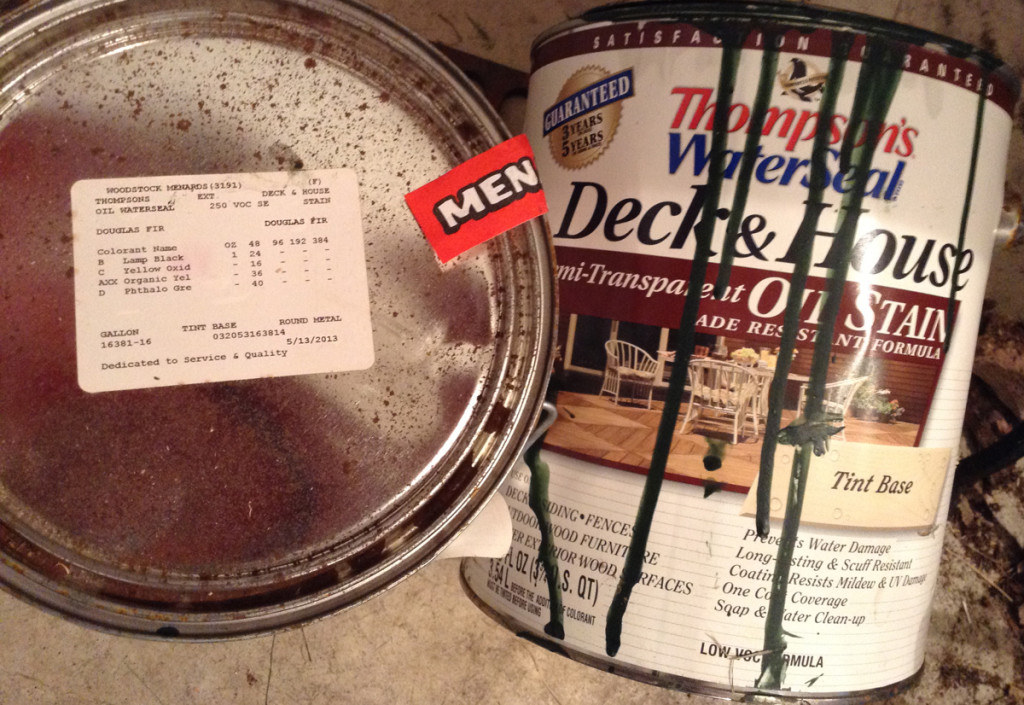
In May of 2013, I selected Thompsons Deck & House Oil Stain Semi-Transparent in a deep shade of Douglas Fir green. I bought it at Menards for under $20 a gallon. I remember being surprised that the product cleaned up with soap and water despite claiming to be an “oil stain” – in retrospect, that should have been my first clue that the product might not perform the way I hoped it would.
I was also extremely surprised when I dipped the brush into the can and applied it to my deck — this product acted far more like a paint than it did a stain. It quickly formed a skin on the top of the wood. It went on easily, but it didn’t soak into the wood the way one would expect a stain to.
After the first brush stroke, I sat on my deck musing over this very un-stain-like “stain.” Then, instead of doing what I should have done… (I should have realized something wasn’t quite right and cut my losses on the stain I’d bought) …I picked up the brush and continued staining.
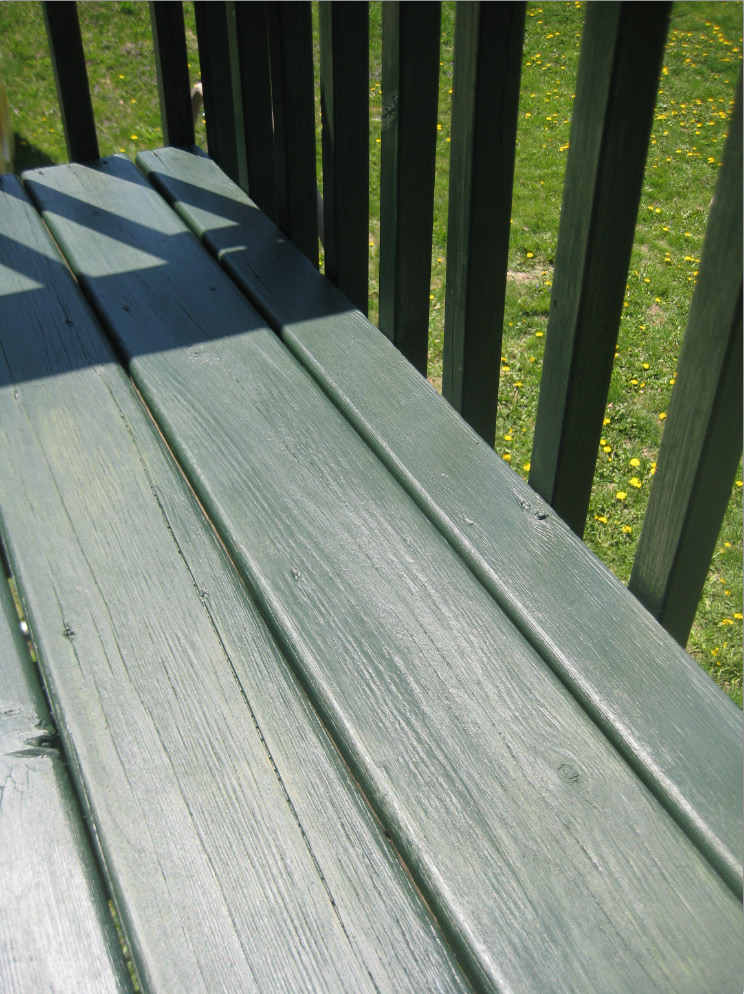
After a long weekend, I was finished. Despite the can’s claim of being “semi-transparent,” this stain indeed was more like a paint that completely covered the wood’s grain, leaving only the wood’s texture visible.
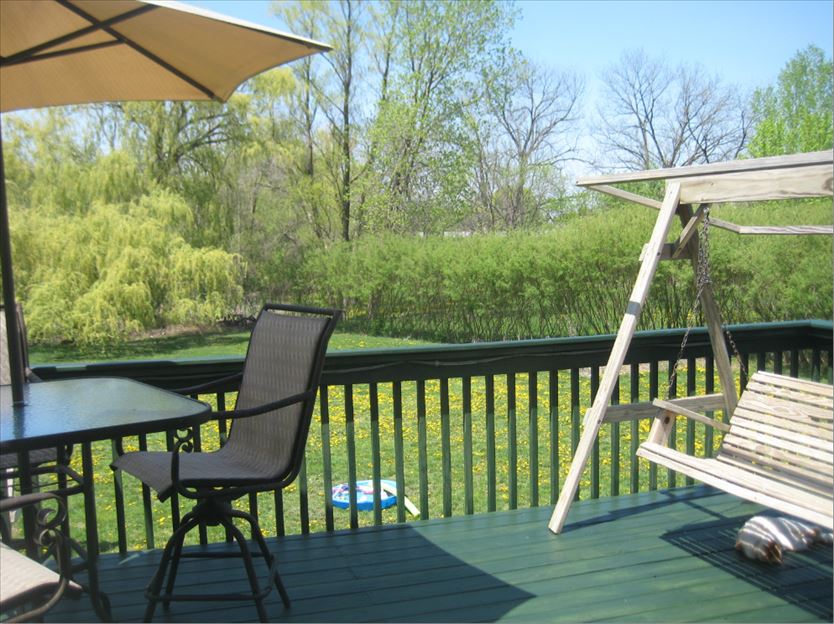
A couple months after staining though, I became even more skeptical about the durability of this Thompson’s stain. Our pets’ nails were chipping the stain off the wood. Anyone sliding or dragging a chair on the deck often left a scratch right through the surface of the green down to the wood.
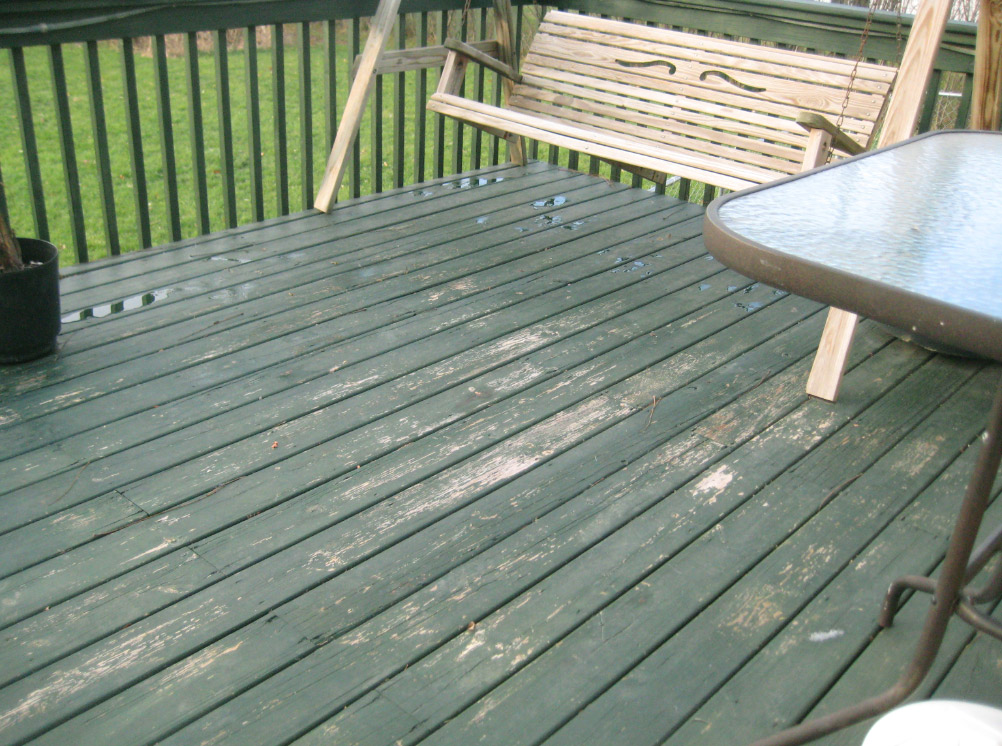
To my dismay, the Thompson’s stain had already begun to crack and peel by the fall of 2013. The following photos were taken in November 2013, six months after staining:
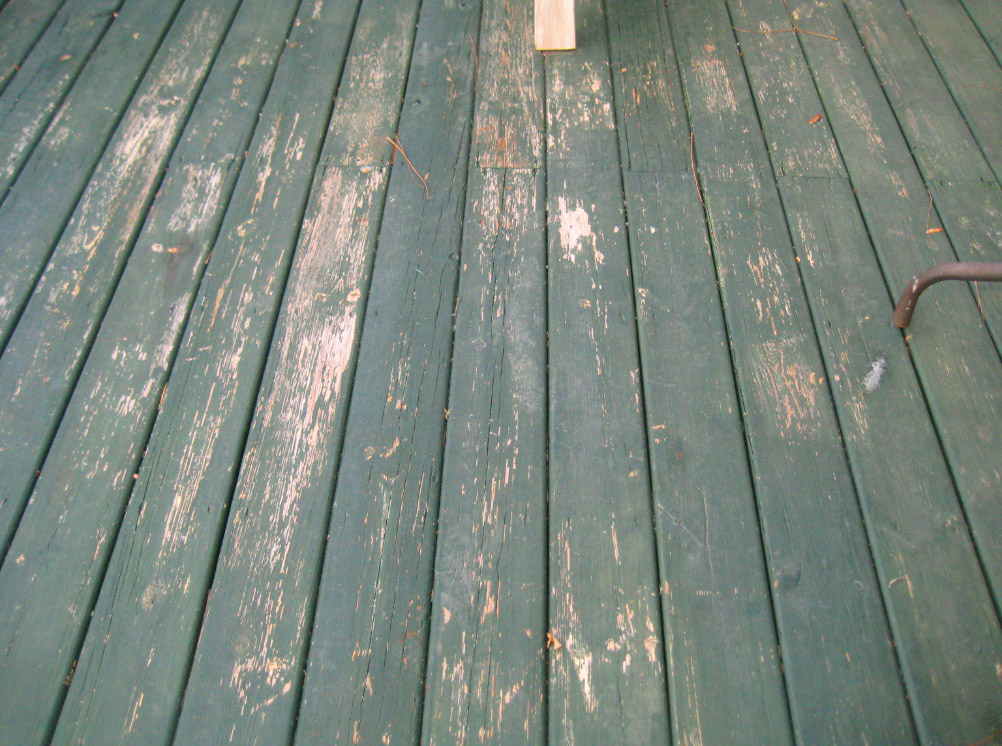
I was so disappointed. Anyone who’s refinished a deck knows how much work it is! Who wants their “newly” stained deck to look like this six months after putting in all of that work — not to mention the money spent on the stain?
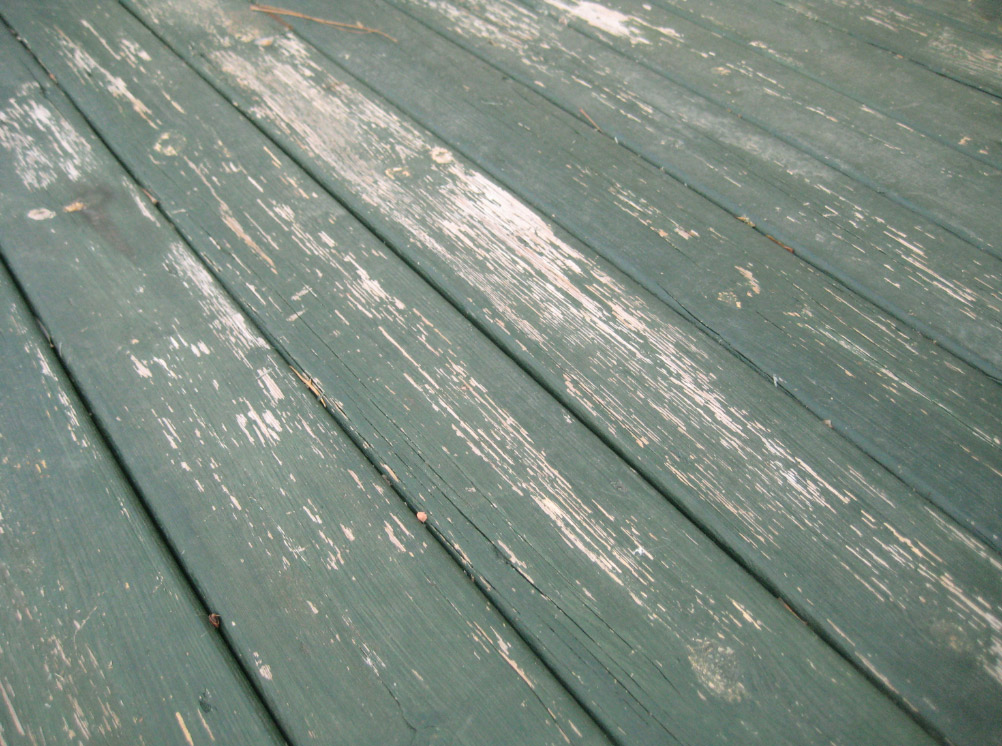
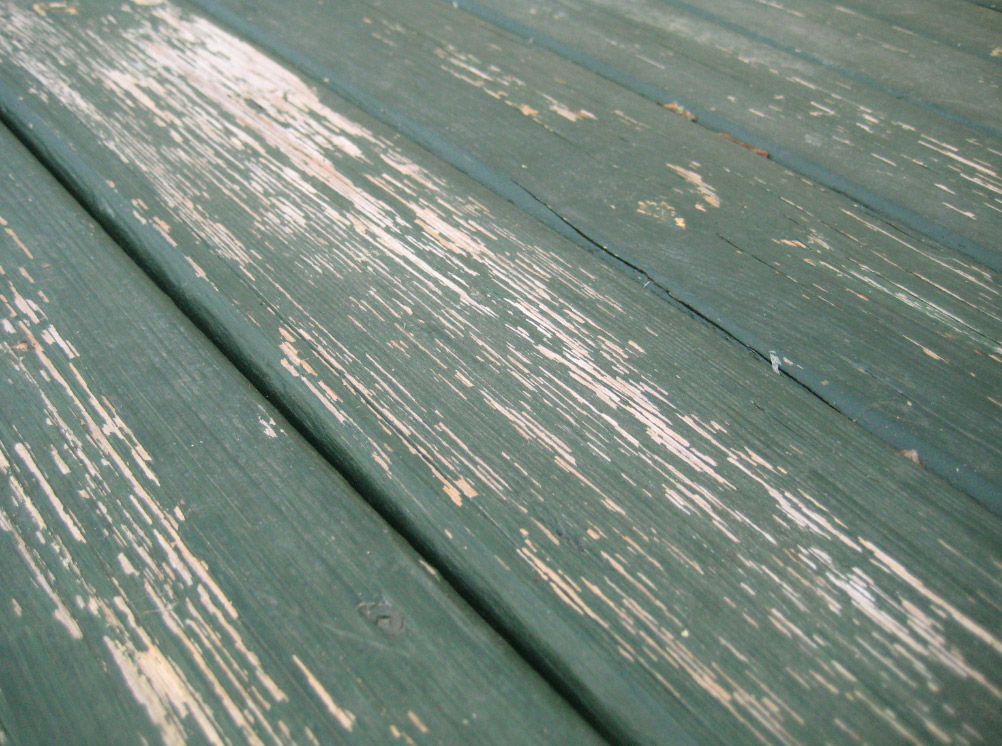
Winter came and went. When the snow finally began melting, it was filled with chips of stain that had lifted off the deck and railings. By springtime 2014, we were dismayed that our deck surface now looked like this — less than a year after I stained it:

The only horizontal areas of stain that didn’t fully lift off were under furniture or got little foot traffic — this green area was under our deck swing and was somewhat protected by the swing over the winter. I used a power washer to blast the rest of the loose stain away.
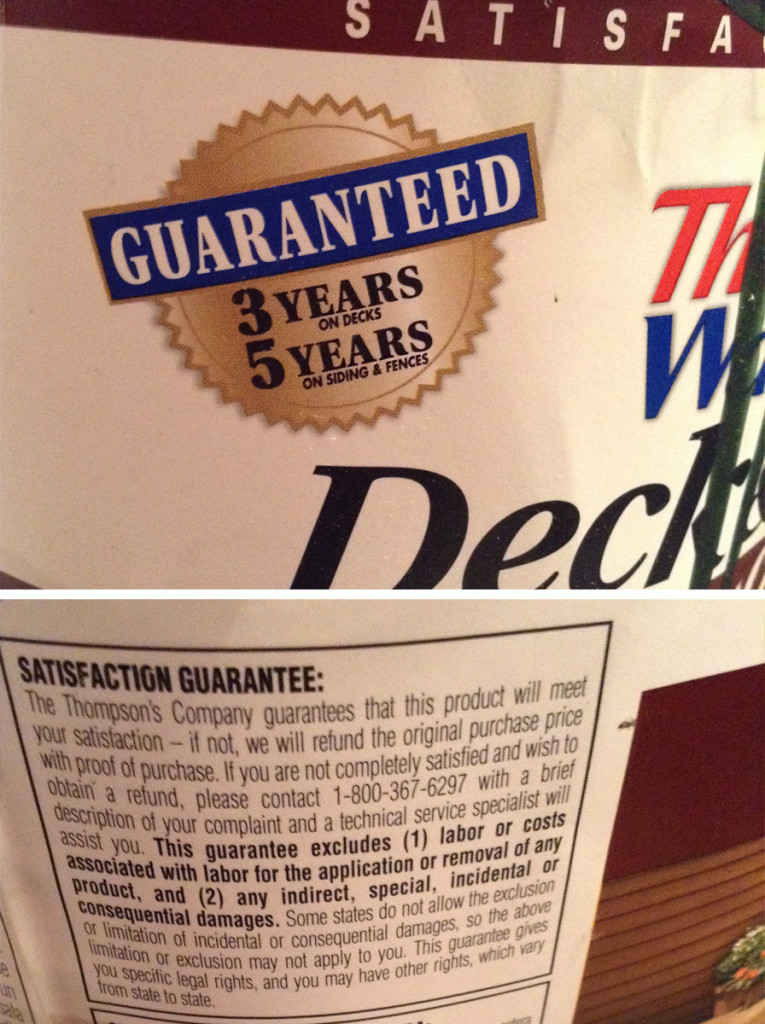
I called Thompsons to complain — I still have the stain cans, which promise “GUARANTEED” 3 years on horizontal surfaces and 5 years on verticals. The rep on the phone gave a range of excuses — everything from “improper application” to “You should not expect stain to last as long on horizontal surfaces as it will on vertical installations.” Without my receipt, they would not refund, even though both cans’ labels have the store’s name, location, date and time that the stain was purchased and tinted printed right on the label.
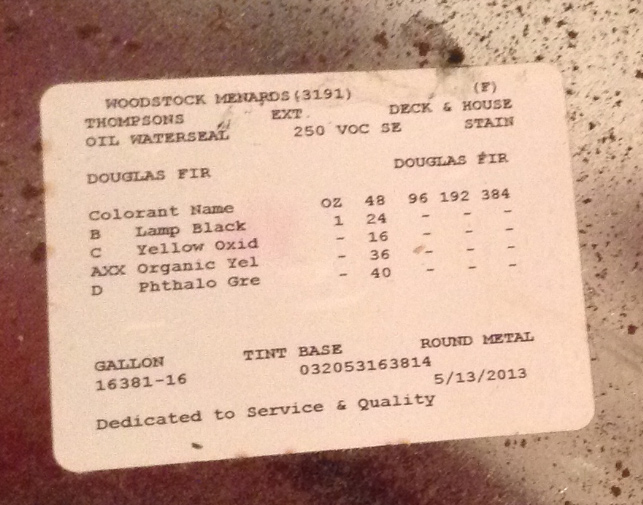
Indeed, the “vertical” portion of the stain’s lifespan may be true. The stain on the vertical surfaces (deck spindles and supports) continues to stay in place to this day more than two years after application, and it still looks pretty good. But the Thompson’s performance on the deck floor and rails was dismal.
I spent most of the summer of 2014 thinking about staining my deck again, while pondering the work and effort that stripping the remaining green stain from over a hundred deck spindles would entail. I definitely didn’t want to go through staining everything again, only to have another stain last less than a year.
With the age of our deck wood, I started looking at some of the old-wood deck solutions too, like Behr DeckOver and Rust-Oleum Deck Restore — both of which look attractive in commercials. These products promise to fill cracks with a thick, resurfacing, sand-based product. I just couldn’t get past all of the bad reviews..! So many homeowners have documented peeling and chipping after just a few months. (If you’re considering either of these, just take a look at this YouTube video, and this one, and this one. Not enough? Here’s another, and another — and you can easily search for many more. These products are expensive, and they don’t appear to last.)
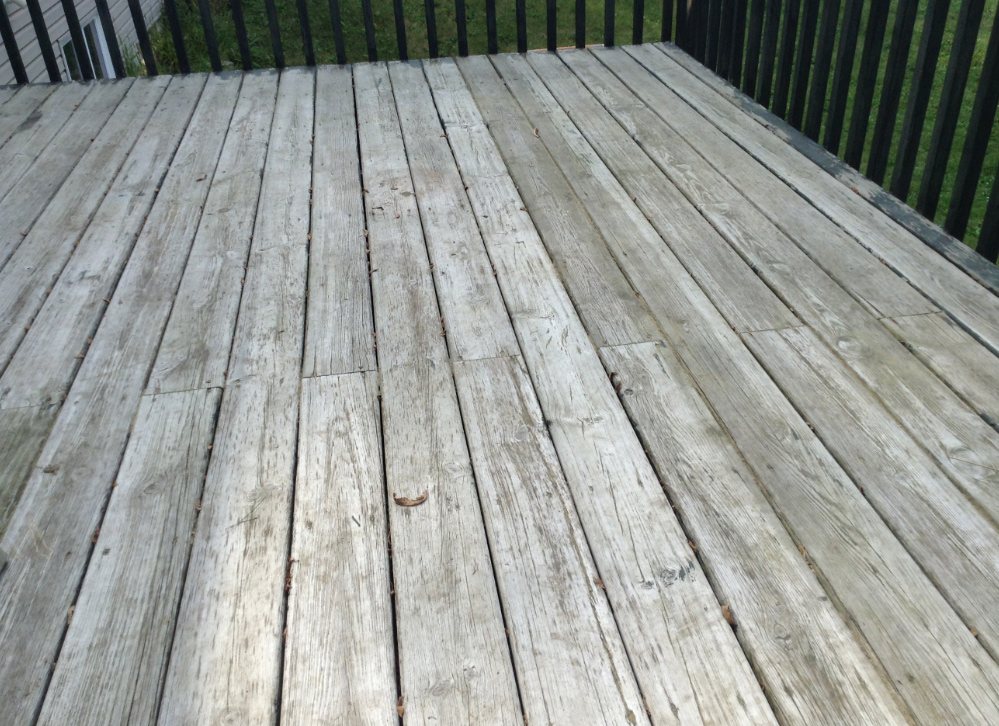
So, 2014 came and went, and we left the deck surface bare. I knew we needed to do something with it, but I wanted to feel confident in whatever product I ultimately decided to go with. After much research over the summer of 2015, in August I finally decided to go with One Time wood stain. This product is more expensive than the usual home-center brands of deck stains, but here’s what I liked about it:
- It’s a true stain that soaks into wood, not a paint-like substance (like that Thompson’s I used in 2013.)
- Because it penetrates and completely soaks into the wood, it cannot chip or peel and has a higher resistance to scratches.
- One Time can be recoated over itself with no stripping. If and when I want to recoat the deck, the manufacturer recommends washing the deck down, letting it dry thoroughly, then staining again. This is huge for me — deck preparation often takes longer than the actual refinishing.
- It is neither water nor oil based — it’s an acrylate resin that cures with UV light (the sun.) The majority of product reviews are very positive
.
- It’s supposed to last 7 years. With our Chicagoland winters, if I get four out of it, I’ll be thrilled!
One Time is not the easiest product to find in stores — you can order it online or find it at a specialty retailer. Some Ace Hardware locations have it, and I special-ordered mine at the Ace Hardware in McHenry, Illinois, which was the closest Ace location to me that could get it. It was $89 per gallon — definitely much pricier than what I’ve used before, but I also hoped that it would perform better and be more durable.
In speaking to a very helpful employee at Ace, he said that One Time is a great product that he often has trouble selling. He said “I can sell $20 and $30 gallons of deck stain all season long… and many of them, I’ll be selling again to the same people next year because they just don’t perform.” He discussed the new government regulations that have restricted VOCs that made deck stains really penetrate and stick, explaining that the One Time is a completely different kind of product that’s patented due to its UV curing technology. He added that people who come in asking for One Time have usually already done their homework on the product and are looking for something better than the average home-center varieties of deck products. (That’s me!)
Because the green Thompson’s stain is still adhering to the spindles and rails of our deck, I decided to leave those areas alone for now and focus on the deck flooring and rails. I floated the idea of a two-tone deck to my husband, and he was fine with it.
One Time only comes in wood tones, so we chose a chestnut brown color. One Time’s documentation notes that the stain can fade up to 10% each year, but the wood protection components will still be in place protecting the decking and preventing water absorption for at least 7 years.

This time around, I wanted to give the stain the best chance at penetrating our deck’s flooring and rails. The One Time documentation warns that the product cannot be applied over old stain, so I wanted to remove all traces of the old stuff. I rented an orbital floor sander and sanded the entire deck surface with an 80 grit prior to application. (Yes, a belt or drum sander would have gone with the grain of the wood, but our wood was looking pretty tired and worn, so the circular sanding of the orbital was not an issue for me.) I figured the orbital was the fastest way to go, and indeed it was — the deck surface was completely stripped in just over an hour. I used my belt sander to strip the handrails and stairs.

Once the deck was prepped, I blasted the sawdust away with an air hose (great trick for removing leaves, dirt and other junk between the boards too!) and began staining. One Time has a pleasant, non-chemical scent — kind of a clean smell. While it’s wet, you can clean it up (off skin, brushes, and say, any drips that might make their way onto your home’s siding) with Simple Green or mineral spirits. Because it requires UV light to cure, this stain stays wet for quite a while. A little goes a long way — the stain’s documentation recommends that you spread it as far as you can without leaving visibly wet areas or pools. I applied it with a brush, and because of the long working time, there are no lap marks between brush strokes. I found it very easy to apply.
One Time is supposed to take 48 hours to cure to the touch & to foot traffic, but it takes three weeks to fully cure. I timed this project around the many hot, sunny, rain-free weeks we had in early September. You’ve seen the “before” photos, so here are some “after” pics:
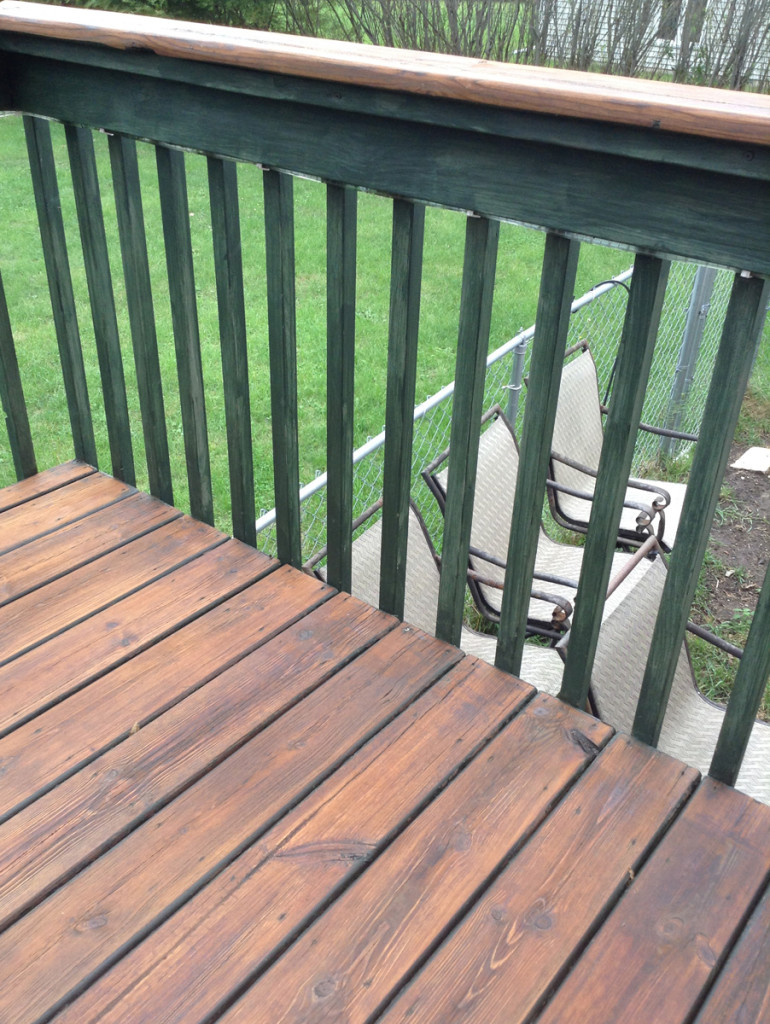

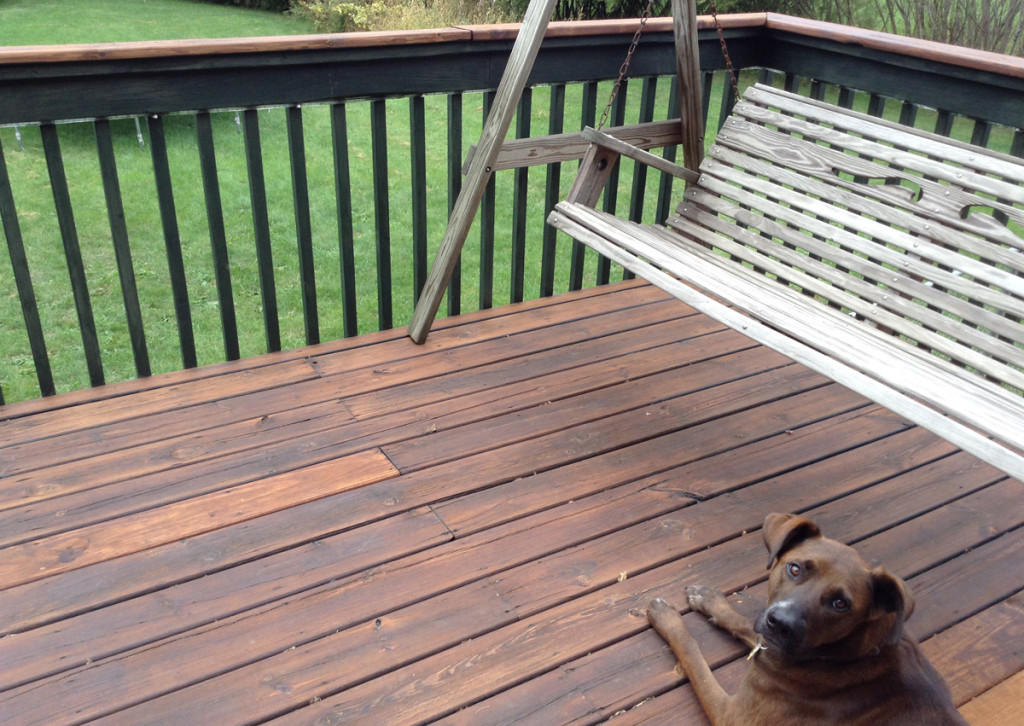
I’m really happy with the way the deck turned out. (And hey, having a two-tone deck isn’t all bad — the colors ended up working together pretty well. Some people might guess we did this intentionally.) I love being able to see the grain of the wood again. I’m also really pleased that the deck looks “healthy” again! The surface wood was looking so worn and beat up after being completely open and uncoated for over a year.
Here’s a photo of the deck after the first rain on it, about a week after I finished staining — nice to see that water beading again!
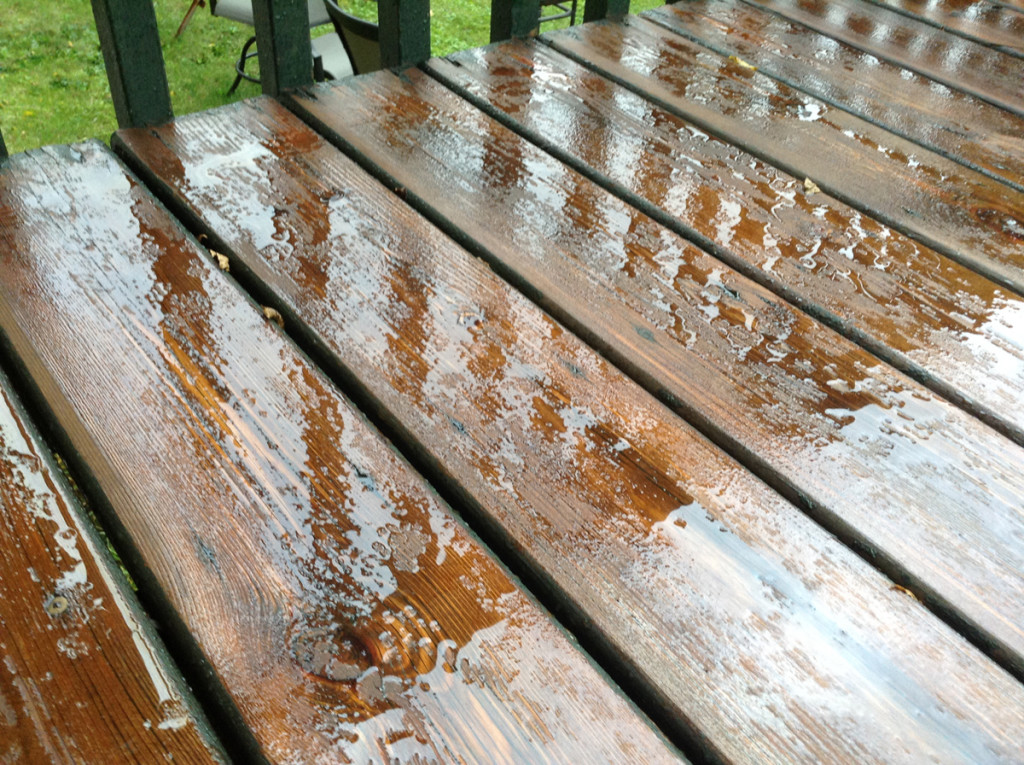
A few more notes and observations: Some of the decking boards still had old green stain in the grain of the wood after sanding:
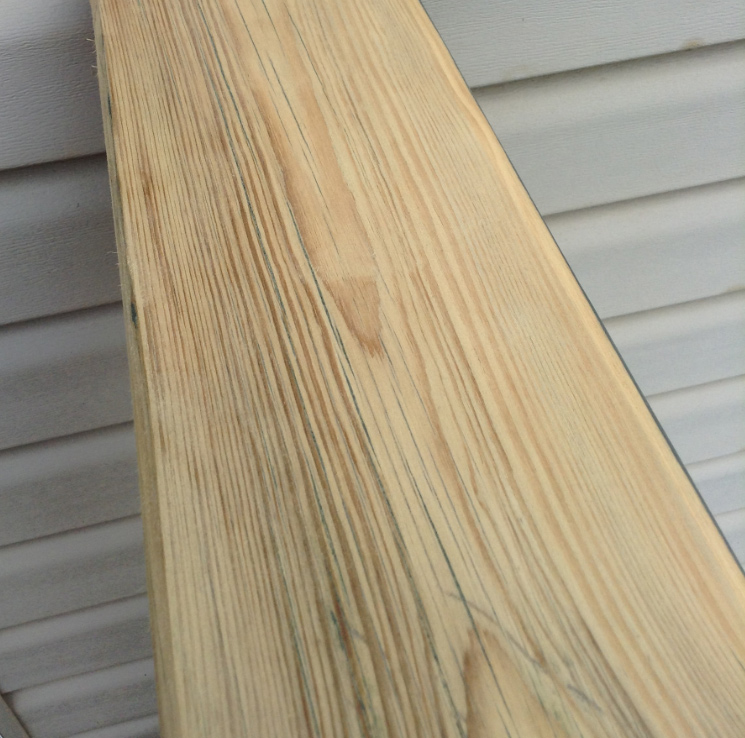
The same was true for some of the cracks between deck boards in the floor — there was no way to sand any remaining green stain off the edges without removing boards from the deck. As there was no way to get all of the old green Thompson’s stain off, I brushed the One Time over the newly-sanded wood and hoped for the best.
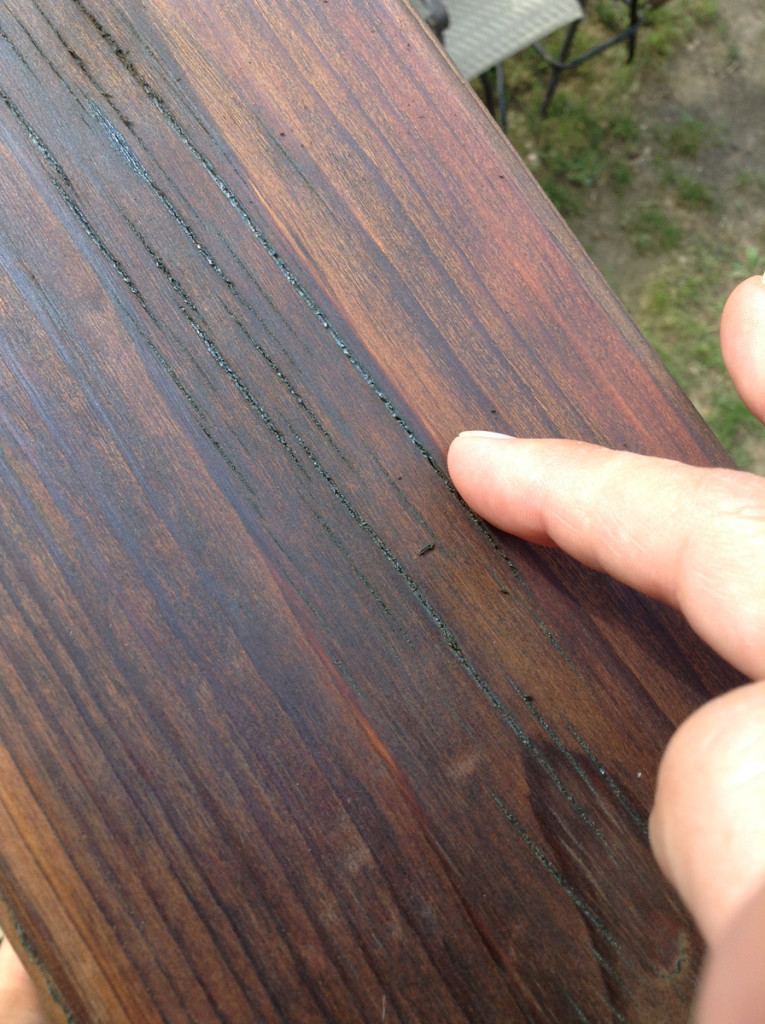
Over the past few weeks, something interesting happened — the One Time appears to have penetrated the wood so deeply that it released the green Thompson’s stain. The remaining “veins” of green stain in the grain of the wood have been forced out vertically by the One Time. I can run my fingers over the wood and brush off the “crumbs” of old Thompson’s stain.
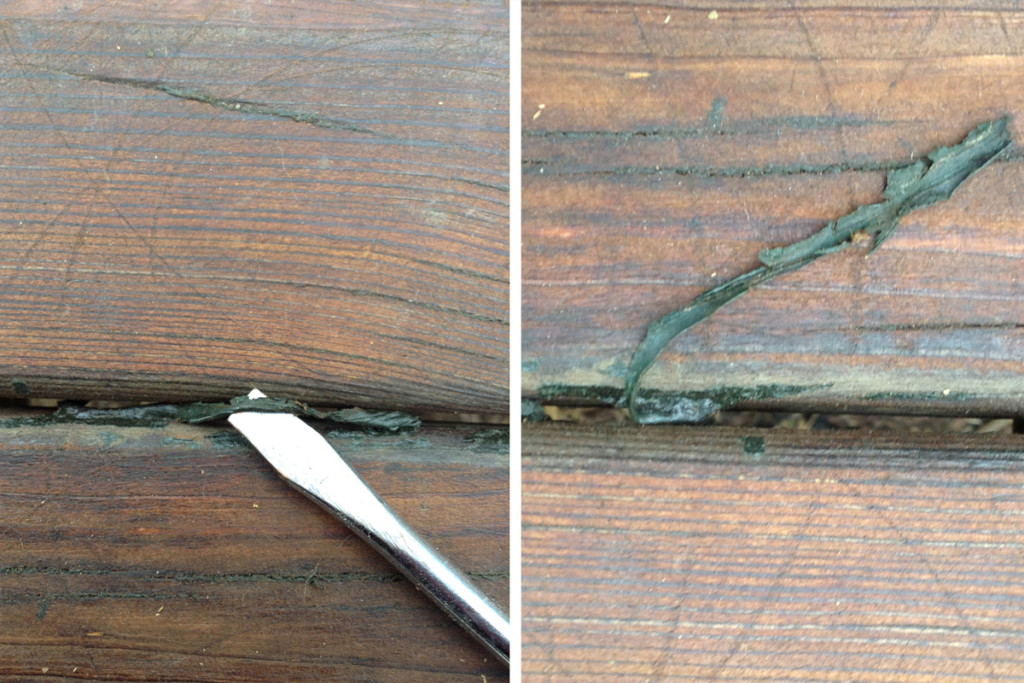
Between the floorboards, long green strips of the old Thompson’s stain have released from the sides of the boards. With a screwdriver, I nudged some of these plastic-y strips away, and the wood underneath them had also been stained chestnut brown. I was impressed by this.
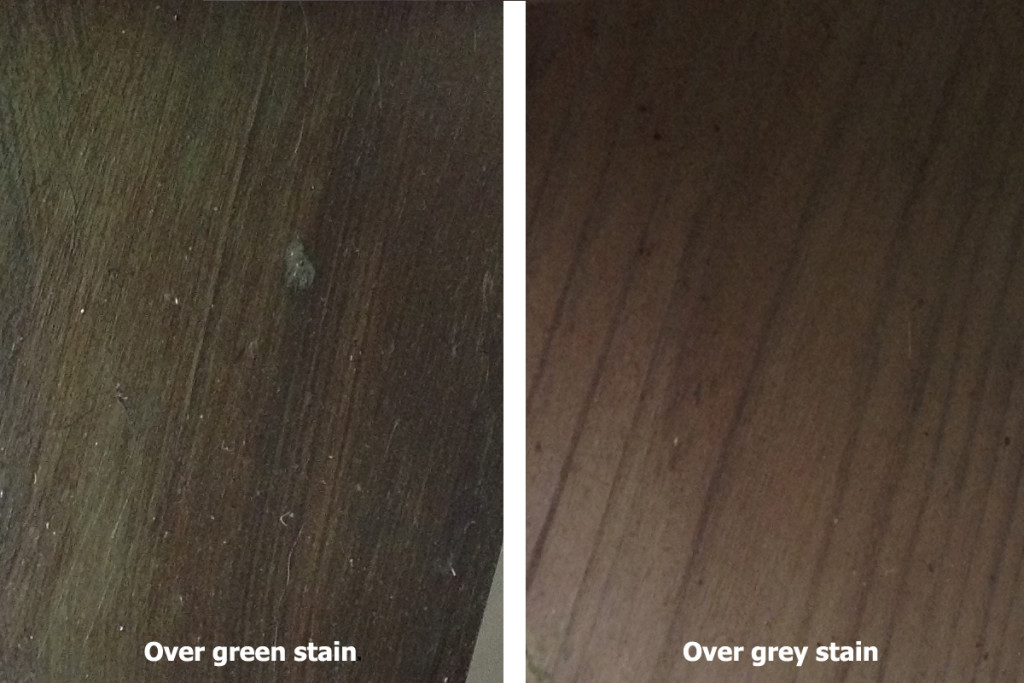
However, the One Time does state that it is not to be applied over old stain. Underneath our deck, I tested it anyway and applied some One Time over the green Thompson’s stain on the back of a stair riser. Another stair had the original grey Olympic stain I stained the deck with 11 years ago (guess I missed that one the last time around!) I brushed some One Time on this too to see what would happen.
In both cases, the One Time stain did not soak in or cure well, nor did it release the old colors underneath. It’s still kind of filmy/sticky and and definitely did not react the way it did on the upper parts of the deck and rails. I believe the only reason the Thompson’s stain was “forced” out by the One Time on our sanded deck surfaces is that enough bare wood was exposed from sanding that the One Time penetrated deeply enough into the wood to displace the old Thompson’s stain.
It took about 1 1/2 gallons of One Time to complete our 12′ x 18′ deck’s floor surface, stairs and rails. Because I special-ordered this through Ace Hardware “late” in the season (August!) they had already clearanced out all of their deck stain for summer, and I had to buy a full case (4 gallons) to complete the special order. I figured that was okay though, as I had some other projects in mind once the deck was complete.
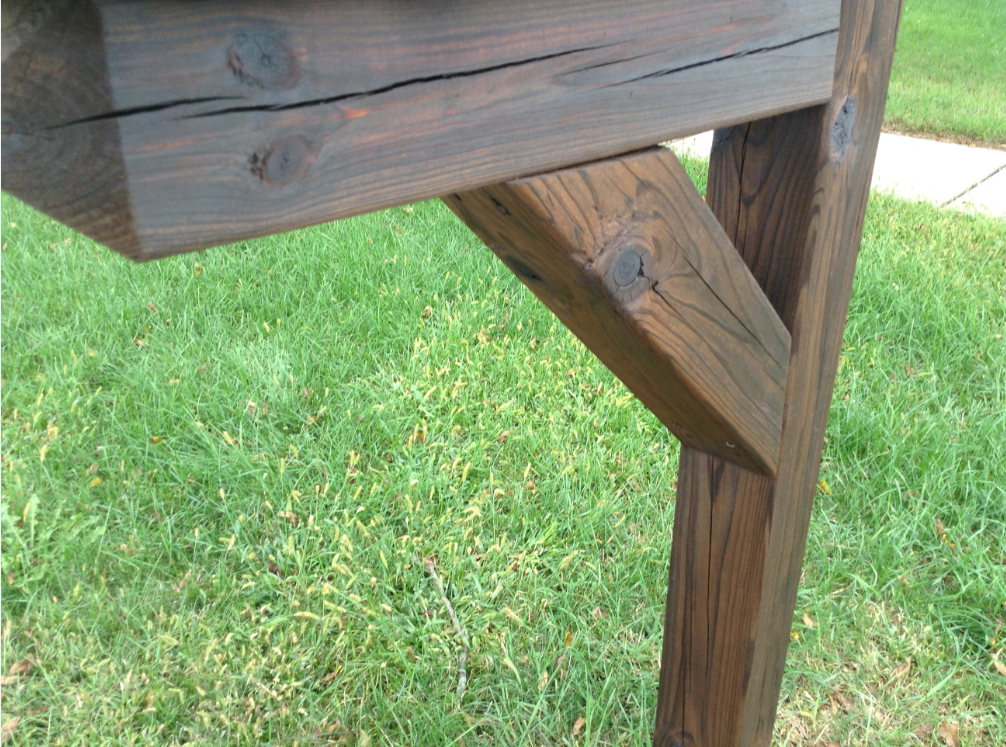
With the wonderful weather we’ve had over the past few weeks, I decided to tackle a few other projects, and I used the One Time to stain our mailbox post and our children’s wood swingset/climber. (Did my blog seem quieter over the past few weeks? This is why – I’ve been really busy outside with all of these wonderful, sunny days!)
Neither of these things had been stained before, so it was interesting to compare how much the stain soaked into the wood for each project.
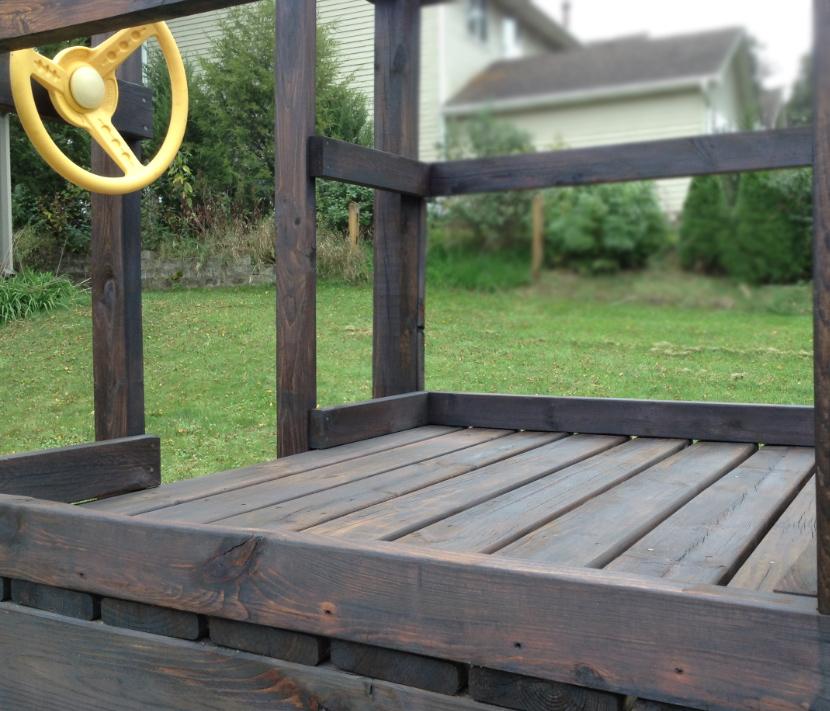
Our mailbox post is four years old (replaced after a snowplow hit it a few years ago) and the kids’ climber is about 20 years old. The mailbox post’s color turned out similar to our deck. However, the same stain soaked into the climber like a sponge. Even though I used the same chestnut color of One Time for all three projects, look at the color difference between the deck and the climber:
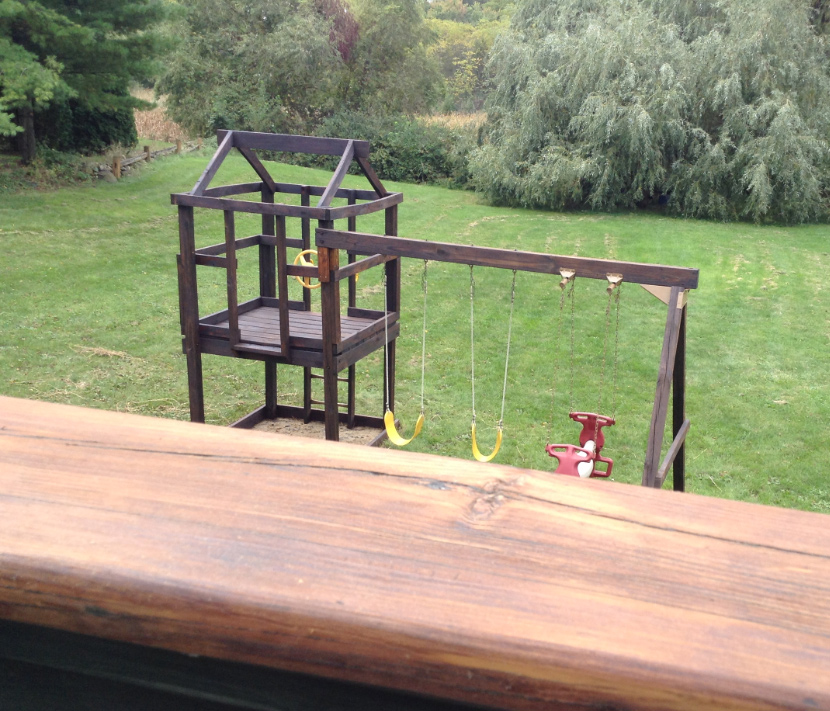
(The kids’ climber is not quite back together yet as it was the final project I finished just last week — it’s missing its slide, walls and roof tarp. Everything’s off so the stain can continue to cure. Our boys, of course, couldn’t wait to get back on it, so the swings went right back up!)
UPDATE: I wrote a second post specifically about the kids’ climber makeover — products used, steps I took, and my encounters with too many wasps’ nests along the way. That post is here.
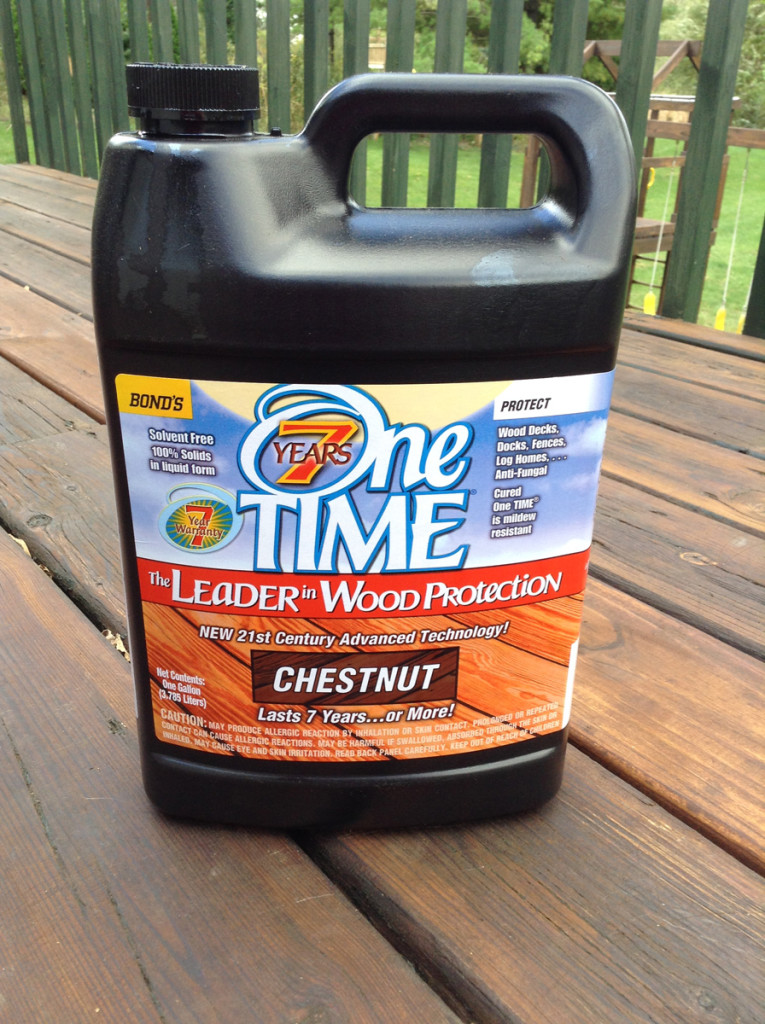
The stain’s documentation does note that consumers can expect a color fade of about 10% each year, but the wood will still be protected from water and the elements for seven years. I’m okay with that, especially considering that One Time can be recoated over itself with no stripping or sanding. That alone makes me wish I had known about this product before my 2013 experience with the Thompson’s.
I’m going to make this post a One Time wood stain “long-term” review-in-progress — I’m sure many other people are looking for a deck product that works, and I have high hopes that the One Time will weather well over the seasons ahead. If it doesn’t, I’ll update my post with that information too, as well as photos of how much the color changes season to season.
2016 Update: One-year-later update showing how One Time deck stain weathered over the past year
2017 Update: Two years later
2018 Update: Three years later!
2019 Update: Four years later!











Sarah says
Thompson’s is known for being a horrible product. I used it once too. Only the first time. Burnt once, but not twice.
Coupon Maven says
Clearly. Their clear Thompson’s Water Seal, which used to be an excellent oil-based product for wood and concrete, has also changed. The old formula used to soak in extremely well and show off the grain of wood. I had an old can left in the garage, as it’s the only thing I’ve ever used on our deck swing (I like the natural grey color of it, so I’ve never stained it.) I used up that old can of waterseal this year, and when I opened a new can, it was white like milk, thicker and difficult to work into the wood. It does not soak into the wood nearly as well as the old, now apparently discontinued, formula did. I thought this was pretty sneaky, because the cans look almost the same.
Take a look at the top of our swing frame. The old-formula Thompsons, a great product, darkens the grain of the wood nicely and soaks in rapidly. I ran out about halfway across the top frame of the swing, then finished sealing the frame with the “new,” milk-like Thompsons. See the difference? I sure can.
I’m REALLY irked, because I’ve had this swing for more than 20 (!) years, and old-oil-base Thompson’s water seal is the only thing I’ve ever used on it. It’s still in great shape. I should have suspected from the non-sticking stain fiasco that their waterseal may not be the same product I’ve trusted for decades. I’m glad I only bought enough to finish this swing stand.
Sherry zbar says
I shared the same issues. I want to send you a photo of what I did to my deck – and I am loving it!
Coupon Maven says
Please do – you can email me at jill@supercouponing.com :) I’d love to see!
hammars says
I read about this product in my Bottom Line publication last year. https://bottomlinepersonal.com/6-thrifty-tricks-to-spruce-up-your-deck/ We wanted to try it this year. We were too busy most of the summer. Found out my mom has stage four cancer a couple months ago, and my husband dislocated his shoulder a month ago, so we will have to wait till spring. I’m too old to do it all myself! Keep us posted how it holds up! BTW Bottom Line is a great publication with all sorts of infomation on a variety of subjects.
Coupon Maven says
Hammars, thanks for the link — another positive review! I feel like I researched the heck out of what to use this time around, so it’s nice to see other recommendations too from a reputable source like Bottom Line.
So sorry to hear about your mom & husband — your deck will still be there next year. Family comes first! I will definitely share how the One Time holds up through the winter and beyond.
hammars says
I picked mine up today! How is yours looking this spring?
Coupon Maven says
I’m SO happy with it. No peeling, no chipping, and the color has stayed true on the deck. On my kids’ climber, it lightened a little bit , though that wood was around 20 years old and had never been stained, so it soaked it up like a sponge. I do need to post new photos soon!
UPDATE: Here’s a new post with one-year-later photo of the deck and climber: https://jillcataldo.com/deck-stain-report-one-year-later/
stain deck says
I am a huge fan of Behr. I have used Thompson’s products in the past and have been disappointed each and every time..
Laura Lea Bassett says
Hi! I found your blog whilst researching the One Time deck stain. I really appreciate your detailed analysis of this product as well as the photographs. I am considering using this product on our new deck (built last summer; now needs to be sealed). Our deck is 19′ x 20′ and is covered. Much of it has limited sun exposure. I’m concerned about this product needing UV light to cure. Do you have any insight into this? Your deck looked fully exposed to the sun…
Coupon Maven says
Yes, our deck is in full sun and cured pretty well. From what I have read, it does indeed require UV light to cure, but it does not need direct sun. As long as it is outside receiving outdoor light from the sun, it should cure, but it will take longer. If this stain were applied fully indoors, it would not cure.
One Time’s site talks about this: https://onetimewood.com/faq/
You could try ordering a sample (there’s a phone number on that FAQ page linked above) from them and applying it to one board, spindle, etc and then seeing how long that takes to cure before deciding to do the entire thing?
John says
Hey, thanks for the suggestion! I also have been tearing my hair out looking for a good deck staain since the new VOC restrictions. This sounds like a very good bet, I will try it.
jOYCE rEID says
I did the same thing as the writer did to spruce up the deck with a deck stain and it went on like paint..I have wrap-around
decks so it is a really big job..it cracked and peeled and its a mess and I am 87 so trying to sand it is out of the question and not in a position to hire it done so I am working with stripping the worst of it and will have to take my chances from
there..replaced one deck and everyone said use Thompson Water Seal…I did…deck is uncovered and it didnt crack or
peel but its all discolored and looks horrible. I thought I could redo it but it wouldnt take the Thompson Seal again..it was as bad as it was when I started. Have another house with a small deck (covered but not enclosed) built in 2002 and I
used Ace oil base deck semi transparent stain when it was built and used a latex deck stain on the underboards around
the bottom of the deck..(it cracked and peeled and has to be redone every year) the semi-oil transparent on the deck lasted with no peeling or cracking or discoloration. Of course it has faded and I have redone it with the same stain
about every 5 years. Fortunately I bought extra stain and still had it on hand. Its a small deck so doesnt take a full
gallon. I re coated it last week and it looks very good, no peeling, cracks etc..just normal wear and tear. I would
never recommend a water clean up stain for exterior use. I wish there was an easy solution to the mess I have
ahead of me on my wrap-around decks. I should have never let anyone talk me into something besides what I
knew and had been using for so many years with no problem.